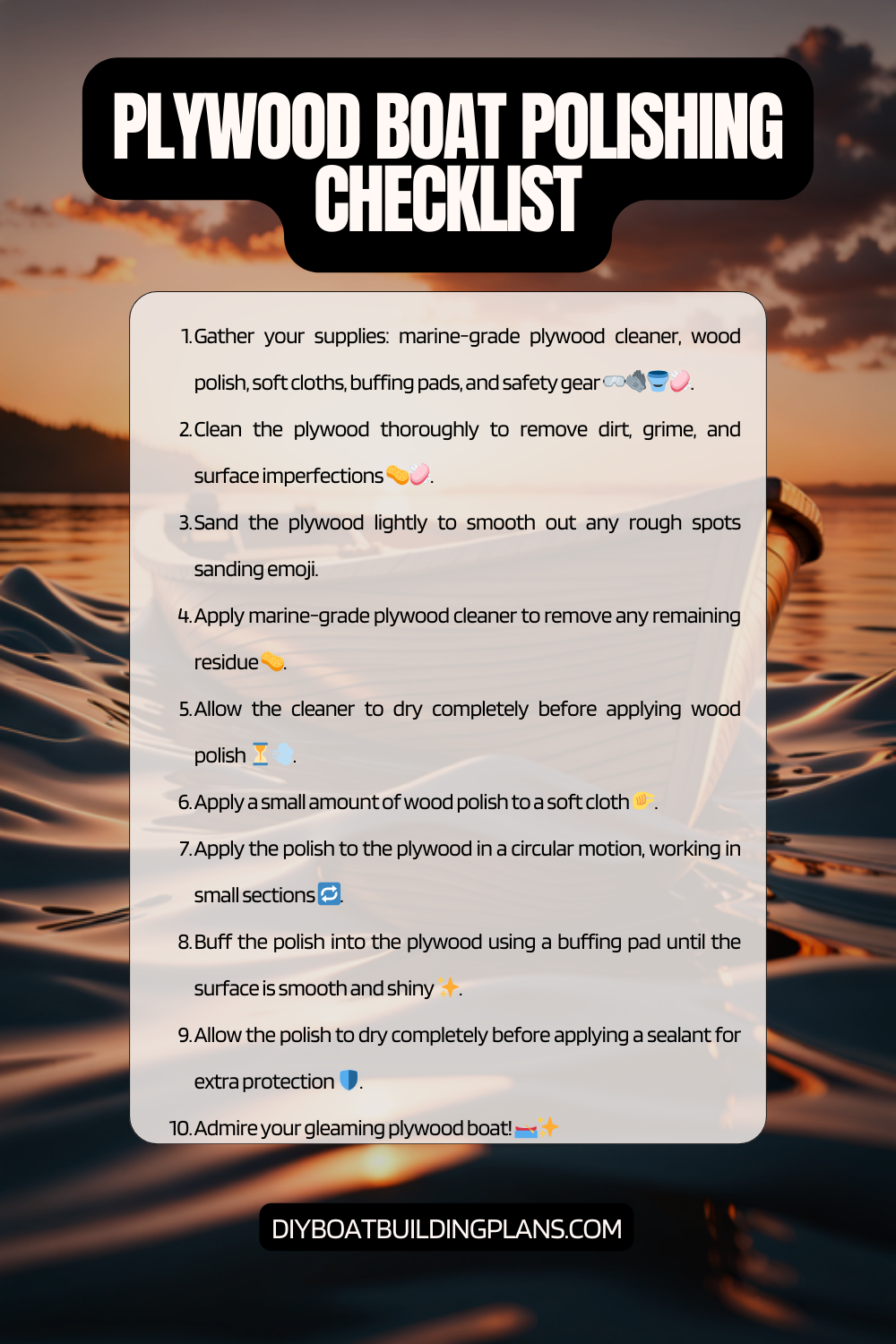Overview of Plywood Boat Polishing Tips
Plywood boats have gained popularity among boating enthusiasts due to their affordability, versatility, and ease of construction. These boats are constructed using layers of plywood that are glued together, creating a strong and durable vessel. However, like any other boat, plywood boats require regular maintenance to ensure their longevity and performance on the water.
Regular maintenance is crucial for plywood boats as it helps prevent damage caused by exposure to water, sunlight, and other environmental factors. Without proper care, plywood can deteriorate over time, leading to leaks, rot, and structural issues. By implementing a regular maintenance routine, boat owners can extend the life of their plywood boats and enjoy many years of safe and enjoyable boating experiences.
Key Takeaways
- Regular polishing is important for maintaining the shine and durability of plywood boats.
- Materials required for polishing plywood boats include sandpaper, polishing compound, and a buffing wheel.
- Choosing the right polish for your plywood boat depends on the type of finish and level of oxidation.
- To maintain the shine on your plywood boat, avoid using harsh chemicals and store it in a covered area when not in use.
- Professional plywood boat polishing may be more expensive, but it can save time and ensure a high-quality finish.

Importance of Polishing Plywood Boats
Polishing plywood boats is an essential part of their maintenance routine. Not only does it enhance the appearance of the boat, but it also provides a protective layer that helps shield the plywood from the elements. Polishing creates a smooth and glossy finish that not only looks great but also makes cleaning easier.
One of the key benefits of polishing plywood boats is that it helps to prevent water penetration into the wood. Plywood is susceptible to moisture damage, which can lead to rot and weakening of the structure. By applying a high-quality polish, boat owners can create a barrier that repels water and prevents it from seeping into the wood.
Furthermore, polishing can also protect the boat from UV rays, which can cause fading and discoloration over time. The polish acts as a shield against the sun’s harmful rays, preserving the vibrant colors of the boat’s exterior. Additionally, polishing can help reduce the accumulation of dirt, grime, and salt deposits on the boat’s surface, making it easier to clean and maintain.
Materials Required for Polishing Plywood Boats
To properly polish a plywood boat, you will need a few essential materials. These include:
1. Boat Polish: Choose a high-quality boat polish specifically designed for use on plywood boats. Look for a polish that offers UV protection and is suitable for the type of finish on your boat.
2. Applicator Pads: Use soft, lint-free applicator pads to apply the polish evenly onto the boat’s surface. Microfiber or foam pads are ideal for this task.
3. Polishing Machine: While not necessary, a polishing machine can make the task easier and more efficient. If using a machine, ensure it has adjustable speed settings to avoid damaging the plywood.
4. Clean Cloths: Have clean, soft cloths on hand to buff and remove excess polish from the boat’s surface.
5. Masking Tape: Use masking tape to protect any areas you do not want to polish, such as metal fittings or windows.
6. Cleaning Products: Before polishing, ensure the boat’s surface is clean and free of dirt and grime. Use mild soap or specialized boat cleaning products to wash the boat thoroughly.
Step-by-Step Guide to Polishing Plywood Boats
| Step | Description |
|---|---|
| 1 | Clean the boat thoroughly with soap and water |
| 2 | Sand the boat with 220-grit sandpaper |
| 3 | Apply a coat of marine-grade polish with a soft cloth |
| 4 | Buff the boat with a polishing wheel or buffer |
| 5 | Apply a second coat of polish and buff again |
| 6 | Repeat steps 3-5 until desired shine is achieved |
| 7 | Apply a final coat of polish and let dry |
1. Preparation: Start by thoroughly cleaning the boat’s surface using mild soap or specialized boat cleaning products. Rinse off any residue and allow the boat to dry completely before proceeding.
2. Masking: Use masking tape to protect any areas you do not want to polish, such as metal fittings or windows. This will prevent accidental damage or staining.
3. Apply Polish: Apply a small amount of boat polish onto an applicator pad. Begin applying the polish in small circular motions, working on one section at a time. Ensure even coverage and avoid applying too much pressure.
4. Buffing: Once the polish has been applied to a section, use a clean cloth to buff the area in straight lines until the polish is evenly distributed and a glossy finish is achieved. Repeat this process for the entire boat, working in manageable sections.
5. Final Touches: After polishing the entire boat, inspect the surface for any missed spots or uneven areas. Apply additional polish as needed and buff until the desired finish is achieved.
6. Clean Up: Remove the masking tape and clean any residue left behind. Dispose of used applicator pads and cloths properly.
Choosing the Right Polish for your Plywood Boat
When choosing a polish for your plywood boat, it is important to consider several factors. Firstly, ensure that the polish is specifically designed for use on plywood boats. This will ensure compatibility with the boat’s surface and provide optimal protection.
Additionally, consider the type of finish on your boat. Some polishes are formulated for glossy finishes, while others are better suited for matte or satin finishes. Read product labels and choose a polish that matches your desired finish.
UV protection is another crucial factor to consider. Look for a polish that offers UV resistance to protect your boat from sun damage and fading. This is especially important if your boat spends a significant amount of time exposed to direct sunlight.
Lastly, consider the ease of application and durability of the polish. Some polishes require multiple coats for optimal results, while others offer long-lasting protection with just one application. Choose a polish that fits your maintenance routine and provides the level of protection you desire.
How Often Should You Polish Your Plywood Boat?
The frequency of polishing your plywood boat depends on several factors, including usage, environmental conditions, and personal preference. As a general guideline, it is recommended to polish your boat at least once a year to maintain its appearance and protect it from the elements.
However, if your boat is frequently exposed to harsh conditions such as saltwater or intense sunlight, more frequent polishing may be necessary. Additionally, if you notice signs of wear or dullness on the boat’s surface, it may be time for a polish.
Regularly inspect your boat for any signs of damage or deterioration. If you notice any issues, such as peeling or cracking of the polish, it is important to address them promptly. By staying proactive and addressing any maintenance needs, you can ensure the longevity and performance of your plywood boat.
Tips for Maintaining the Shine on Your Plywood Boat
In addition to regular polishing, there are several tips and best practices for maintaining the shine on your plywood boat between polishes:
1. Rinse After Use: After each boating trip, rinse your boat with fresh water to remove any salt or debris that may have accumulated. This will help prevent staining and corrosion.
2. Use Mild Cleaning Products: When cleaning your boat, use mild soap or specialized boat cleaning products. Avoid harsh chemicals or abrasive cleaners that can damage the finish.
3. Avoid Scratches: Be mindful of sharp objects or rough surfaces that can scratch the boat’s surface. Use fenders or protective covers when docking or storing the boat to prevent accidental damage.
4. Regular Inspections: Regularly inspect your boat for any signs of damage, such as cracks, chips, or peeling polish. Address these issues promptly to prevent further damage and maintain the appearance of your boat.
5. Store Properly: When not in use, store your plywood boat in a dry and covered area to protect it from the elements. If storing outdoors, use a boat cover to shield it from sunlight, rain, and debris.
By following these tips and incorporating them into your regular maintenance routine, you can keep your plywood boat looking its best between polishes.
Common Mistakes to Avoid While Polishing Plywood Boats
While polishing plywood boats is a relatively straightforward process, there are some common mistakes that should be avoided to prevent damage to your boat:
1. Using the Wrong Polish: Ensure that you are using a polish specifically designed for plywood boats. Using the wrong type of polish can lead to poor adhesion, discoloration, or even damage to the boat’s surface.
2. Applying Too Much Pressure: When applying polish, avoid using excessive pressure. Applying too much pressure can cause the polish to penetrate the wood, leading to discoloration or warping.
3. Skipping Surface Preparation: Properly preparing the boat’s surface before polishing is crucial for achieving a professional finish. Skipping this step can result in poor adhesion and an uneven appearance.
4. Neglecting to Buff: After applying the polish, it is important to buff the surface to remove excess product and achieve a smooth finish. Neglecting this step can result in a sticky or uneven surface.
5. Overlooking Masking: Masking tape is essential for protecting areas you do not want to polish, such as metal fittings or windows. Failing to use masking tape can result in accidental damage or staining.
By avoiding these common mistakes and following the proper techniques, you can ensure a successful and damage-free polishing process for your plywood boat.
Download over 500 Boat Plans. Click on the link below.
-->Click Here<--
Polishing vs. Waxing: Which is Better for Plywood Boats?
When it comes to maintaining plywood boats, there is often a debate between polishing and waxing. Both methods offer their own benefits and considerations:
Polishing: Polishing involves using a specialized boat polish to create a smooth and glossy finish on the boat’s surface. It provides UV protection, repels water, and enhances the appearance of the boat. Polishing is ideal for plywood boats as it helps prevent water penetration into the wood and protects against sun damage.
Waxing: Waxing involves applying a protective layer of wax onto the boat’s surface. It provides a barrier against water, UV rays, and other environmental factors. While waxing can provide some level of protection for plywood boats, it may not be as effective as polishing in terms of water resistance and durability.
Ultimately, the choice between polishing and waxing depends on personal preference and the specific needs of your plywood boat. If you prioritize water resistance and long-lasting protection, polishing is the recommended option. However, if you prefer a quick and easy maintenance routine, waxing can still provide some level of protection for your boat.
DIY vs. Professional Plywood Boat Polishing: Pros and Cons
Deciding whether to polish your plywood boat yourself or hire a professional is a decision that depends on several factors:
DIY Polishing:
Pros:
1. Cost Savings: Polishing your boat yourself can save money compared to hiring a professional.
2. Flexibility: You can choose when and how often to polish your boat based on your schedule and preferences.
3. Learning Experience: Polishing your boat yourself allows you to learn about its maintenance needs and gain hands-on experience.
Cons:
1. Time-Consuming: Polishing a plywood boat can be a time-consuming task, especially for larger boats or if you are new to the process.
2. Skill and Equipment: Achieving a professional finish requires skill and the right equipment. If you lack experience or the necessary tools, the results may not be as desired.
3. Potential for Mistakes: Without proper knowledge and technique, there is a risk of making mistakes that could damage your boat’s surface.
Professional Polishing:
Pros:
1. Expertise: Hiring a professional ensures that your boat will be polished by someone with experience and knowledge in the field.
2. Time-Saving: Professionals have the necessary tools and equipment to complete the job efficiently, saving you time and effort.
3. Professional Finish: A professional polish can provide a higher level of quality and attention to detail compared to DIY methods.
Cons:
1. Cost: Hiring a professional can be more expensive than doing it yourself, especially for larger boats or if additional services are required.
2. Scheduling: You may need to coordinate with the professional’s availability, which may not always align with your preferred timeline.
3. Lack of Control: When hiring a professional, you relinquish some control over the process and may need to trust their judgment and expertise.
Consider your budget, time availability, skill level, and desired outcome when deciding whether to polish your plywood boat yourself or hire a professional. Both options have their pros and cons, so choose the one that best suits your needs and preferences.
Plywood Boat Polishing Checklist

Conclusion – Plywood Boat Polishing Tips
In conclusion, regular maintenance and polishing are essential for maintaining the appearance and longevity of plywood boats. Polishing provides a protective layer that repels water, shields against UV rays, and enhances the boat’s overall appearance. By following a step-by-step guide and using the right materials, boat owners can achieve a professional finish and protect their investment.
When choosing a polish, consider factors such as compatibility with plywood, UV protection, and ease of application. Additionally, be mindful of common mistakes to avoid during the polishing process, such as using the wrong polish or applying too much pressure.
Maintaining the shine on your plywood boat between polishes involves rinsing after use, using mild cleaning products, avoiding scratches, regular inspections, and proper storage. By incorporating these tips into your maintenance routine, you can keep your boat looking its best.
Lastly, deciding whether to polish your plywood boat yourself or hire a professional depends on various factors such as cost, time availability, skill level, and desired outcome. Consider the pros and cons of each option before making a decision.
In conclusion, regular polishing is crucial for maintaining the beauty and performance of plywood boats. By investing time and effort into proper maintenance, boat owners can enjoy many years of safe and enjoyable boating experiences on their plywood boats.
FAQs – Plywood Boat Polishing Tips
What is plywood boat polishing?
Plywood boat polishing is the process of cleaning and shining the surface of a plywood boat to improve its appearance and protect it from damage caused by exposure to water, sun, and other environmental factors.
Why is plywood boat polishing important?
Plywood boat polishing is important because it helps to maintain the appearance and integrity of the boat’s surface. It also helps to protect the boat from damage caused by exposure to water, sun, and other environmental factors.
What are some tips for polishing a plywood boat?
Some tips for polishing a plywood boat include using a high-quality boat polish, applying the polish in a circular motion with a soft cloth, and buffing the surface with a clean, dry cloth. It is also important to avoid using abrasive cleaners or tools that could scratch or damage the surface of the boat.
How often should a plywood boat be polished?
The frequency with which a plywood boat should be polished depends on a variety of factors, including the age and condition of the boat, the amount of use it receives, and the environmental conditions to which it is exposed. In general, it is recommended that a plywood boat be polished at least once a year to maintain its appearance and protect its surface.
What are some common mistakes to avoid when polishing a plywood boat?
Some common mistakes to avoid when polishing a plywood boat include using abrasive cleaners or tools that could scratch or damage the surface of the boat, applying too much pressure when polishing, and failing to properly clean and dry the surface of the boat before applying polish. It is also important to avoid polishing in direct sunlight or extreme temperatures, as this can cause the polish to dry too quickly and leave streaks or other imperfections.



